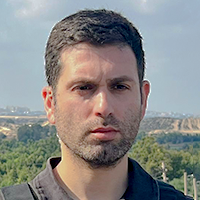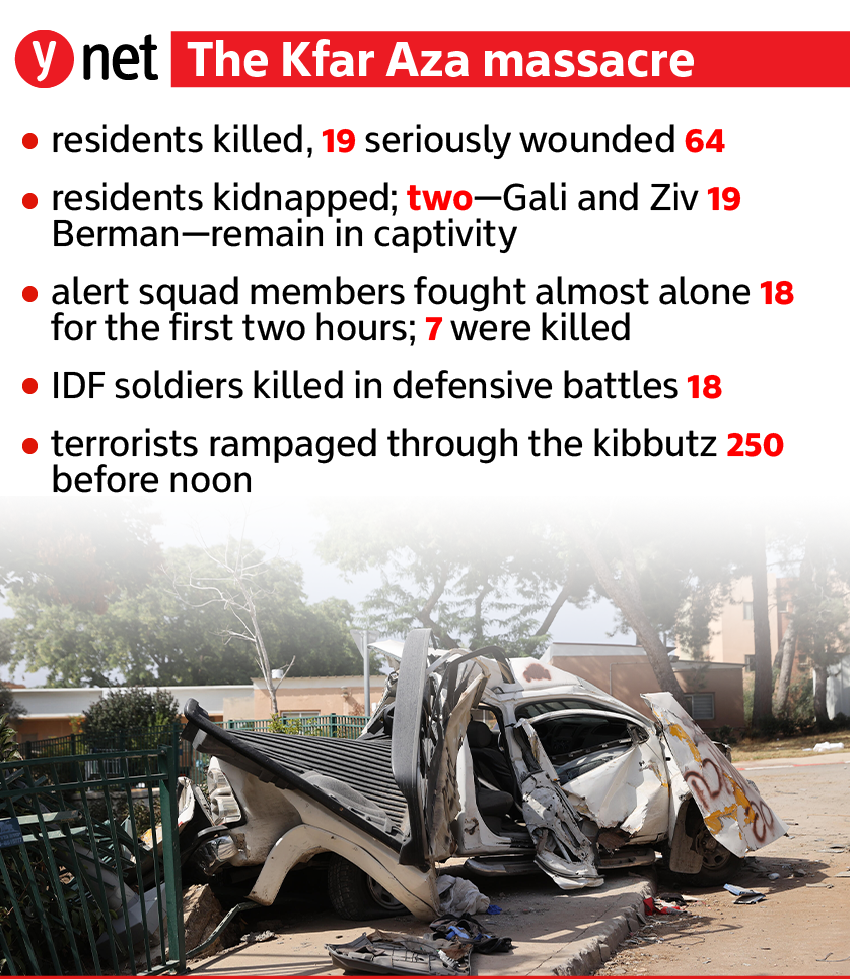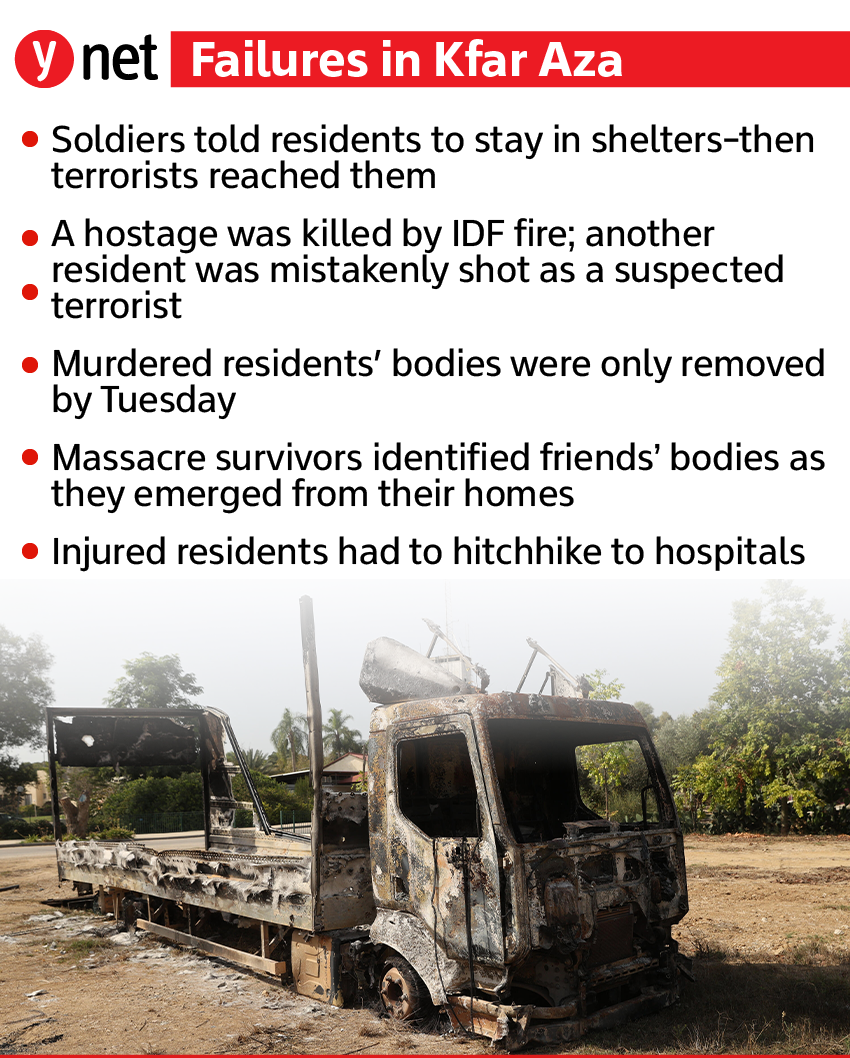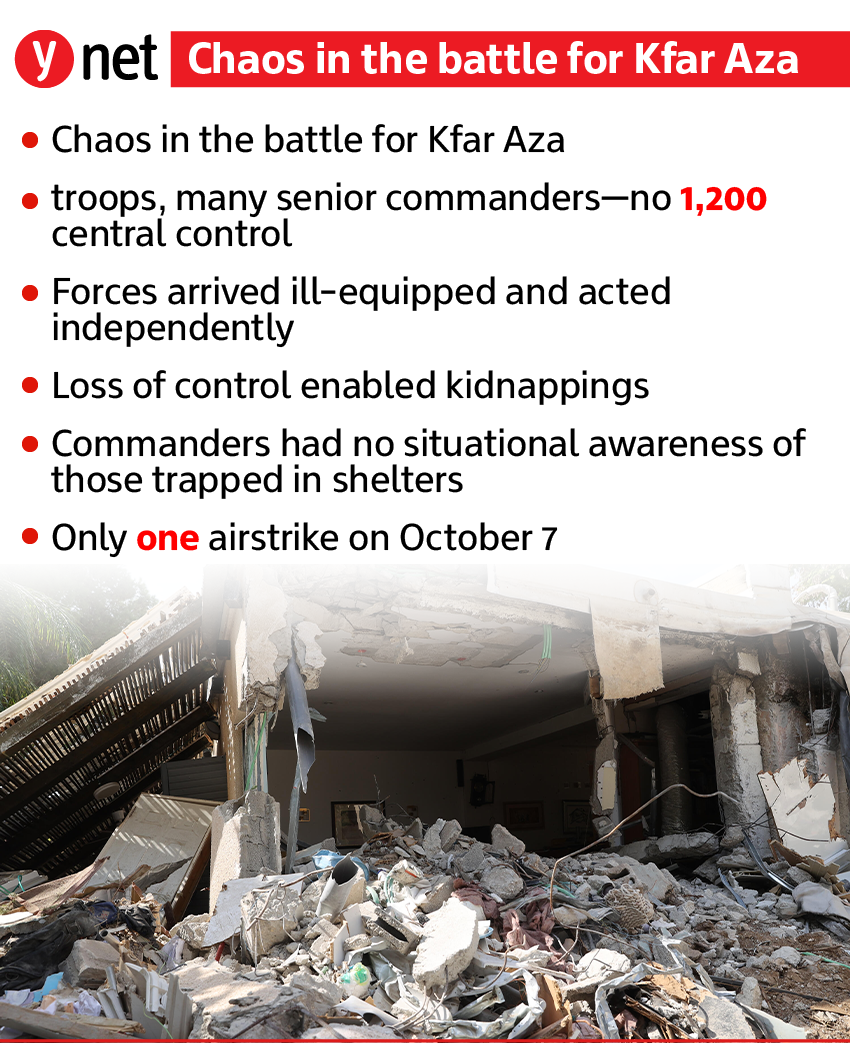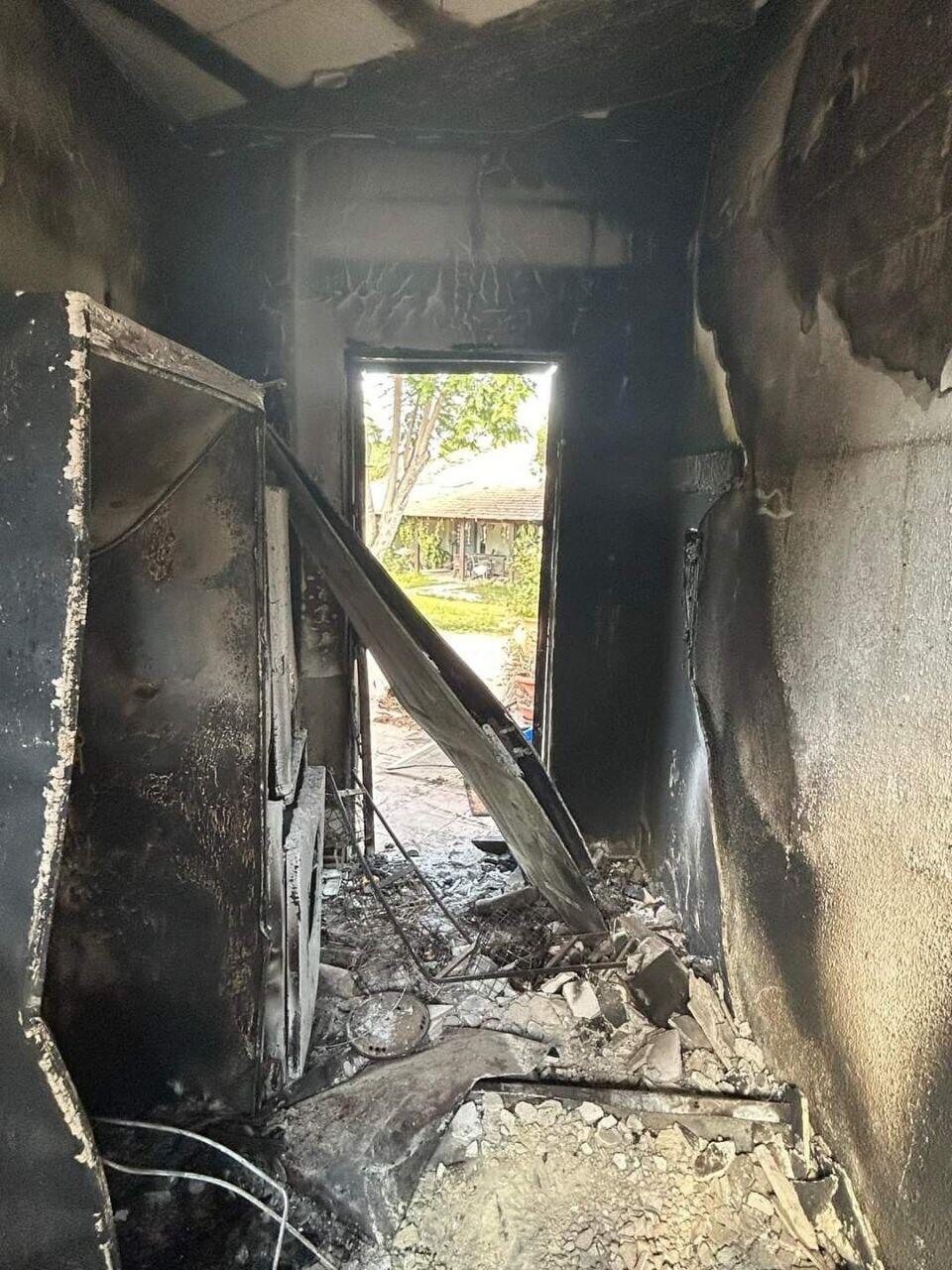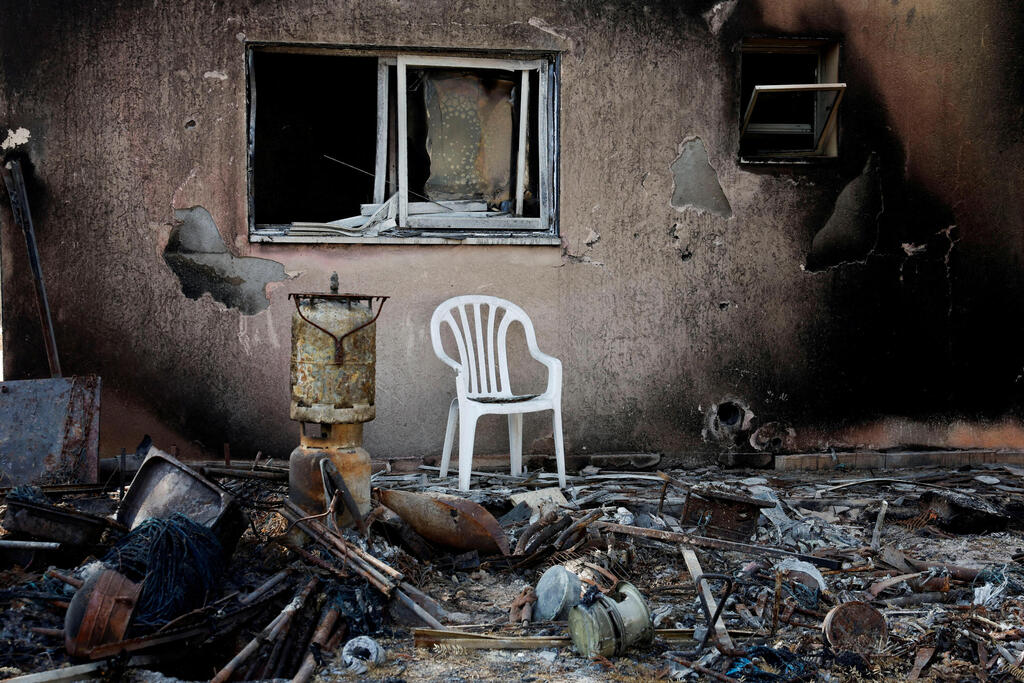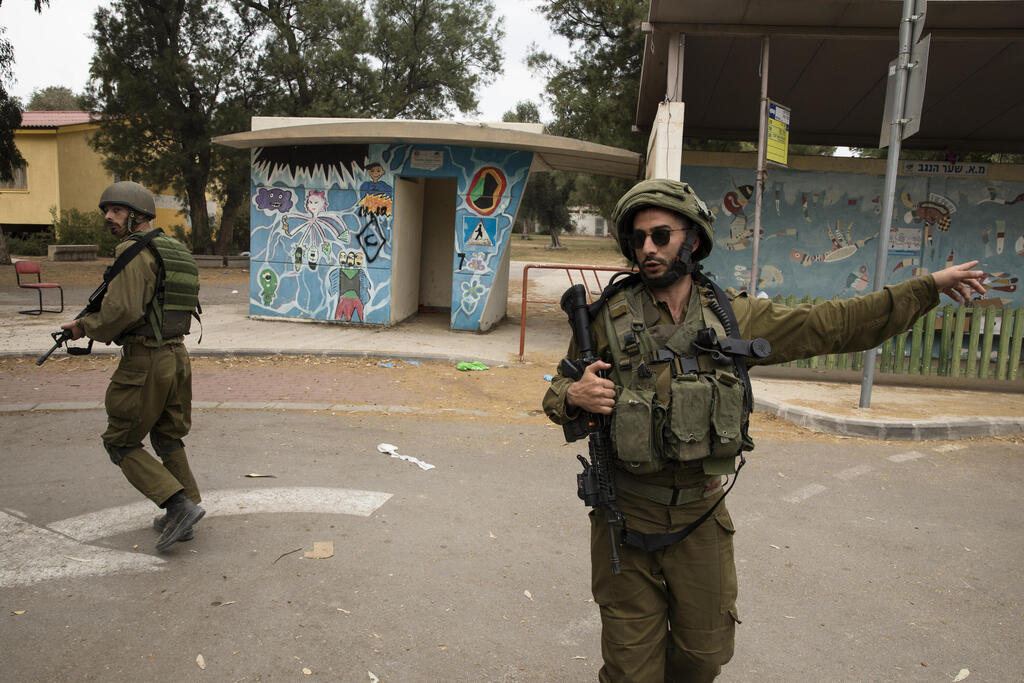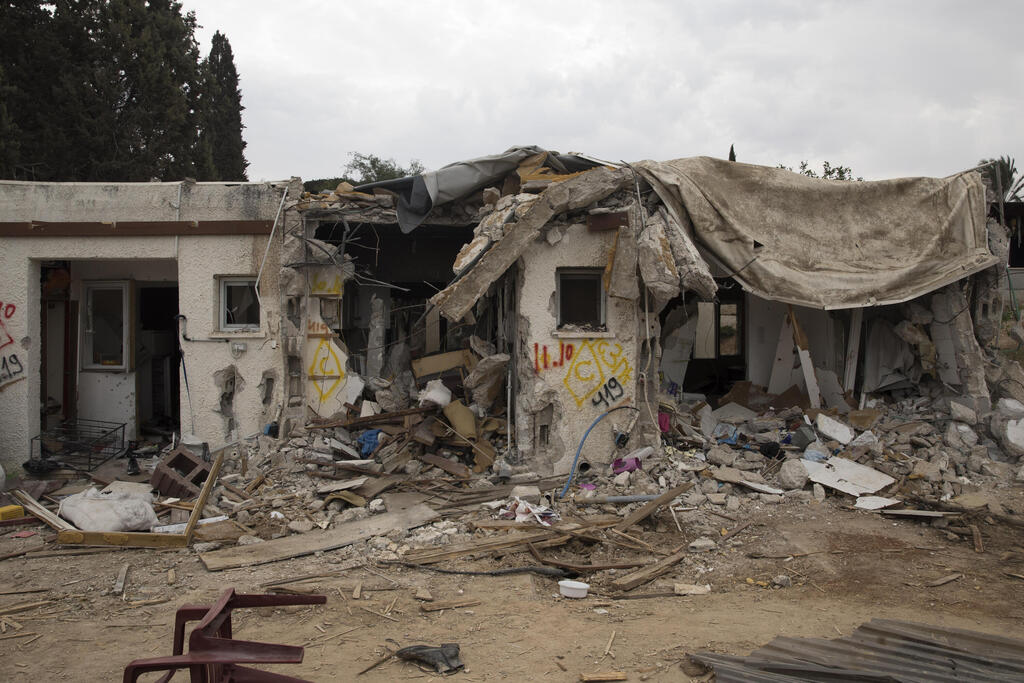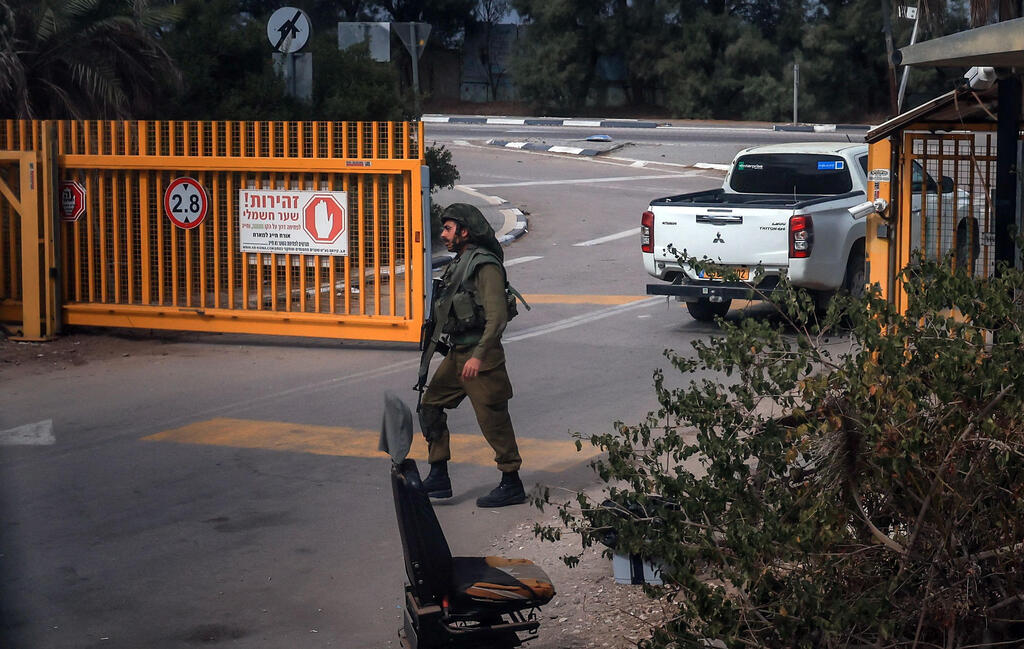Seven hundred combat troops, battalion and brigade commanders and two division commanders were present, yet none were able to contain the horrific attack.
Cries for help went unanswered as the first forces arrived in the Young Generation neighborhood, much after several residents had already been abducted.
Instead of evacuating residents, they were instructed to remain in their safe rooms—where the terrorists ultimately reached them. Others were evacuated to the kibbutz gate and told to hitch rides from there.
The IDF's official inquiry focused on one of the more problematic decisions made by senior command in the past decade: a significant reduction in troop deployments along the Gaza border on weekends and holidays. While Israelis were unaware of this policy, Hamas was not. The terror group exploited it to the fullest—not only in the massacre at Kfar Aza, where 64 residents were murdered and 19 were abducted, including Gili and Ziv Berman, who remain in captivity—but also in the wounding of many others and the near-total destruction of the kibbutz.
Eighteen IDF soldiers were killed defending Kfar Aza. Half of the force assigned to protect it was on leave for the holiday. The probe found that it took approximately two hours before a small, insufficient force arrived to ward off the attack, despite the kibbutz being just three kilometers (under two miles) from the Nahal Oz military base. By then, 200 terrorists of Hamas' elite Nukhba force had already overrun the community.
For those two hours of unrelenting violence, the kibbutz was defended solely by its 18-member alert squad. Seven were killed, and others fought on despite being wounded and lost valuable time in retrieving weapons from an armory that had been locked under IDF orders.
The decision to allow so many troops to take leave—made out of concern for their well-being—has since been reversed, albeit belatedly.
There were many acts of heroism that day. One example highlighted in the IDF inquiry was that of 22-year-old Neta Epstein, who threw himself onto a grenade hurled into his safe room, sacrificing his life to save his partner.
Military intelligence failed to detect Hamas’ preparations for the massacre, which began on Friday evening. By dawn Saturday, dozens of terrorists were already in vehicles, waiting for the order to attack.
At 6:29 a.m., Hamas launched 960 rockets and missiles at IDF positions along the border to pin down any reinforcements. That was the signal for terrorists to storm the border fence, which was breached near Kfar Aza at three points: 6:35, 6:41 and 6:43 a.m.
At the same time, six Nukhba terrorists on gliders landed in the kibbutz—a moment captured on film by Ynet photographer Roy Edan, who was murdered in the attack. His young daughter, Abigail, witnessed her father's killing before being taken from his arms and abducted to Gaza. According to the IDF probe, a Hamas terrorist told Abigail to run to the neighbors, who were later taken hostage as well.
Initially, 80 terrorists infiltrated Kfar Aza, later joined by 170 more in two subsequent waves. Unlike in other communities and military posts, they looted relatively little. According to intelligence, most of the terrorists in Kfar Aza had planned to continue their assault on Kibbutz Sa’ad—where their attack was thwarted—and on the city of Sderot. Instead, they remained in Kfar Aza.
The terrorists took up fortified positions inside the kibbutz. Around noon, an IDF officer arrived and found a hand radio near a terrorist’s body. He overheard orders instructing the terrorists to “stay in the kibbutz and prepare for a long battle.”
The intelligence failures leading up to the massacre continued throughout the attack. No one in the elite SIGINIT Unit 8200 thought to monitor the communications of terrorists who had already infiltrated Israel. The attackers were prepared for an extended battle, bringing advanced first aid kits to treat their wounded, along with military equipment and ammunition to last for days.
The destruction in Kfar Aza was among the most extensive that day. Six of the kibbutz’s eight neighborhoods were devastated. In the Young Generation neighborhood, 11 of the 37 residents were murdered, and seven were abducted.
At the peak of the assault, 250 terrorists were inside Kfar Aza, using it as a staging ground for swift movement. In addition to motorcycles, pickup trucks and private vehicles they had driven from Gaza, they also used cars and even bicycles belonging to kibbutz members. Only two families, realizing the danger early, managed to escape by car.
The IDF carried out seven airstrikes to support Kfar Aza, but only one occurred on the day of the attack; the rest took place the following day. Another 19 airstrikes were launched on Saturday elsewhere, seemingly slowing down additional terrorists heading toward the kibbutz.
Despite the presence of three battalion commanders, three brigadiers and two division commanders—including one kibbutz resident who fought the terrorists with only a knife—along with 1,200 reinforcements from 24 units, no senior officer was able to take control of the chaos.
As a result, most Kfar Aza residents remained trapped in their safe rooms with the wounded and dead for two more days as the fighting continued into a third day. The last resident was murdered on Saturday at 6 p.m., and the final soldier was killed on Tuesday afternoon. A total of 101 terrorist bodies were found inside the kibbutz, but most of the attackers managed to escape back to Gaza. The last terrorist inside Kfar Aza was killed on Tuesday at 5:30 p.m.
The IDF inquiry concluded that misplaced confidence in the Gaza border barrier led to an inadequate defense strategy, creating dangerous gaps in situational awareness and operational readiness.
For an entire day, troops operated without command and control. They arrived without proper combat gear, and even by evening, many were still acting independently, without clear orders from the Southern Command or IDF General Staff. The lack of coordination enabled further kidnappings. Until late Saturday night, no force managed to secure the three-to-four-kilometer stretch between Kfar Aza and the border.
Senior officers did not fully grasp the plight of the besieged residents for half a day. It was only after two officers managed to reach the command post at the kibbutz entrance, which was set up Saturday evening, that a clearer picture emerged.
Residents, particularly those evacuated late, reported seeing IDF forces remaining outside the kibbutz. However, according to the investigation, only a few troops hesitated to enter, primarily in the morning hours. Most of the forces seen outside were medical teams and administrative personnel.
The investigation praised the United Hatzalah emergency response organization for dispatching ambulances into the combat zone and saving many lives. The IDF said that Magen David Adom (MDA), Israel’s primary ambulance service, did not cooperate with the inquiry.
The findings revealed that, in some instances, IDF forces did not treat residents appropriately. Some wounded civilians, evacuated only to the entrance of the kibbutz, were left to hitch rides to hospitals—even on Saturday night. The bodies of murdered residents were removed late, only on Tuesday, and survivors of the massacre were exposed to horrific scenes during an evacuation that was largely unsecured. Numerous desperate pleas for assistance from residents to the IDF went unanswered.
"We did not properly instruct soldiers on how to evacuate civilians, so the blame does not lie with them. In the Young Generation neighborhood, trapped residents cried out for help even during the night," the IDF acknowledged. "There is a need for an external review of the events at Kibbutz Kfar Aza. At this stage, no personal conclusions have been drawn—some lessons have yet to be learned, while others have already been implemented."
Minute by minute: The massacre at Kfar Aza
6:42 – 6:45 a.m.: Following a barrage of dozens of rockets and mortars targeting the kibbutz, which began at 6:30 a.m., six Hamas terrorists land inside Kfar Aza as an advance force, arriving on three motorized paragliders. From the air, they fire at residents, some of whom are still outside their homes, trying to grasp what is happening. This is likely when Ynet photographer Roy Edan was murdered, after managing to capture the first moments of the infiltration. His young daughter, Abigail, was later abducted, while his wife, Shin Bet employee Smadar Mor Edan, was killed in the family's reinforced safe room shortly after.
6:50 – 6:54 a.m.: The first pickup truck carrying terrorists enters the kibbutz through the rear solar-powered gate, which was breached with an explosive charge. Almost simultaneously, Hamas operatives break through three sections of the border fence. Another terrorist vehicle enters via a second rear gate, intended for pedestrian use. The attackers spot 72-year-old kibbutz resident David “Kachko” Katzir on his morning run and kill him—making him the first victim of the massacre.
6:55 a.m.: The terrorists know exactly where the kibbutz armory is located—possibly due to intelligence provided by Gazan laborers who had worked in the community, according to the investigation. Members of the local alert squad rush to retrieve their locked weapons, but the attackers head there as well, aiming to neutralize the defense force. Heavy fighting erupts. Among those battling the terrorists is Brig. Gen. (res.) Israel Shomer, a resident of the kibbutz and former commander of the 146th Division. At 6:40 a.m., he had managed to call IDF Chief of Staff Herzi Halevi and Southern Command head Maj. Gen. Yaron Finkelman, reporting the situation.
7:25 a.m.: A regional force, including a single tank, reaches the outskirts of Kfar Aza. It was dispatched by company commander Shilo Har-Even, who later fell in battle at the Nahal Oz military base and has since been recommended for the Medal of Valor. However, from the tank’s position, its crew is unable to fully assess the chaos unfolding inside the kibbutz. The tank’s communication systems were damaged at the onset of the attack, and its crew struggles to operate their mounted machine guns due to the sustained fire.
Unable to reach Golani Brigade officers engaged in fierce combat elsewhere, the tank commander contacts his direct superior from the 77th Armored Battalion. The officer advises him to leave Kfar Aza and redeploy southward to other battle zones. “I didn’t understand the full picture of what was happening inside, so I left,” the tank crew later explained.
Meanwhile, the rest of the regional Golani forces are engaged in heavy defensive battles between the Nahal Oz military base and Kibbutz Nahal Oz, as well as on the border bridge, trying to repel the mass Hamas infiltration.
7:28 a.m.: Dorrit Wertheim, 54, who was responsible for distributing emergency messages to kibbutz residents, is murdered. A fellow resident takes over the critical task of providing guidance to the community, but communication on WhatsApp remains unsynchronized with the IDF.
7:30 a.m.: Another 150 Hamas Nukhba terrorists infiltrate the kibbutz, entering through a third breach near the Young Generation neighborhood, adjacent to the perimeter road. By this point, there are already 10 Hamas pickup trucks and multiple motorcycles inside the kibbutz, each carrying two terrorists. The attackers go house to house, killing residents in cold blood. When they find many safe rooms locked, they decide to set them on fire.
8:30 a.m.: For the first time since the attack began, an initial IDF force arrives—a small, outnumbered contingent from the regional battalion, unable to shift control from Hamas. The force is led by Capt. (res.) B., commander of Company B from the 13th Battalion, who arrives under orders from Battalion Commander Lt. Col. Tomer Greenberg, who was returning from weekend leave. (Greenberg was later killed in Gaza during the war.) B. takes an armored personnel carrier (Namer) from the battalion’s reserve near Kibbutz Alumim and advances into Kfar Aza, where 150 terrorists are still present and 37 residents have already been murdered.
Two Golani reconnaissance jeeps are sent toward the kibbutz, but their troops decide to continue north rather than enter. “We looked in the rearview mirror and saw an RPG rocket pass right by us, so we decided to head toward Kibbutz Mefalsim,” they later told investigators. The same soldiers eventually reached Sderot, where they played a key role in the heroic battle at the city's captured police station.
Get the Ynetnews app on your smartphone: Google Play: https://bit.ly/4eJ37pE | Apple App Store: https://bit.ly/3ZL7iNv
8:33 a.m.: Capt. B.’s armored personnel carrier runs over several terrorists and relies primarily on WhatsApp messages from residents to determine where to go and where wounded civilians need rescue. At 8:42 a.m., the first attack helicopter is deployed at B.’s request, conducting a strike to isolate the kibbutz from external threats.
9:44 a.m.: A joint force of 15 police officers and soldiers arrives at the kibbutz after navigating Hamas ambushes that have effectively cut off the area by targeting roads and intersections. The force is immediately engaged upon entry, sustaining casualties but managing to eliminate several terrorists.
10:34 a.m.: A military force from the Duvdevan unit, consisting of 16 soldiers in two armored vehicles from the Samaria region, enters the kibbutz and is immediately drawn into heavy fighting, including anti-tank fire targeting their vehicles. The unit is aided by a fellow Duvdevan soldier who lives in the kibbutz and helps guide them. During the battle, the force loses six soldiers. At one point, they spot a man emerging from a house with a shotgun, mistake him for a terrorist, and fatally shoot him. Meanwhile, a small team from Sayeret Matkal arrives at the kibbutz, splitting into two groups. Four of them attempt to flank the enemy but are ambushed and killed at close range by terrorists hiding inside a house.
10:46 a.m.: The commander of the elite Maglan unit arrives at the kibbutz with a small force, along with undercover officers from the Israel Police’s Southern District. Simultaneously, a force from the Paratroopers' 890th Battalion enters the kibbutz. The various units attempt to organize combat teams, divide sectors and launch counterattacks against the large number of terrorists still inside.
11:00 a.m.: Brig. Gen. Dan Goldfuss, commander of the 98th Division, arrives at the kibbutz by chance and fights alongside Maglan soldiers for about an hour. He then leaves to assume command of the wider battle zone and orders the commander of the Commando Brigade to take charge of all operations inside the kibbutz.
11:24 a.m.: Chief Superintendent Shimon Portal, an intelligence officer from the Israel Police’s Southern District, arrives at the kibbutz to rescue his daughter and other young people trapped in the Young Generation neighborhood. His presence proves critical, and the intelligence he relays back helps military commanders realize that the IDF must concentrate its efforts on this area, where many terrorists are barricaded inside fortified prefab homes, along with stunned civilians.
11:48 a.m.: A second Duvdevan force enters Kfar Aza with 53 regular soldiers. During the two-hour period from 10:00 a.m. to 12:00 p.m., despite the arrival of initial reinforcements, 18 residents are murdered, 19 are abducted to Gaza and seven soldiers are killed. Only 18 civilians are successfully evacuated from the kibbutz during this time.
12:50 p.m.: A military force arrives at the Young Generation neighborhood, hours late—after the abductions have already taken place, but with many terrorists still barricaded inside small apartments and safe rooms alongside terrified residents. Despite repeated pleas for help, no rescue had come until now. Confusion reigns across the kibbutz, where hundreds of soldiers are now present, but no single commander is coordinating them. “We went house to house, saw residents, confirmed they were okay and just told them to stay in their safe rooms instead of evacuating them,” soldiers later told investigators. “After we left and continued searching, terrorists reached some of them.”
1:30 p.m.: Brig. Gen. Shomer joins forces with the Paratroopers’ 202nd Battalion. As they advance toward the Young Generation neighborhood, they encounter heavy resistance, with soldiers killed in the fighting. Meanwhile, the commander of the Jerusalem District Counterterrorism Unit is alerted by one of his officers inside the kibbutz, who directs him toward the embattled neighborhood and warns of a large ambush at its entrance.
1:52 p.m.: Lt. Col. Tomer Greenberg, commander of the 13th Battalion, leads a force of around 50 soldiers from Duvdevan and Sayeret Matkal into the Young Generation neighborhood. However, breaching the fortified buildings proves difficult. A Namer armored personnel carrier attempts to ram through buildings with limited intelligence on whether terrorists, civilians or both are inside.
2:00 – 4:00 p.m.: By this point, more than 700 soldiers are in the kibbutz, including Givati Brigade Commander Col. Liron Batito, who joins the fighting. Yet no one considers deploying forces to isolate the area. Many terrorists remain hidden in the surrounding fields, launching attacks on soldiers into the night, including along the kibbutz’s perimeter fence.
4:00 p.m.: A unit from the elite Shaldag reconnaissance force is dispatched to locate 10-month-old twins from the Berdichevsky family, whose parents, Itay and Hadar, were murdered that morning. The infants are found crying by IDF soldiers and finally evacuated to safety at 8:00 p.m. by Lt. Col. Greenberg.
5:00 p.m.: For the first time, Givati Brigade Commander Col. Liron Batito assigns combat sectors within the kibbutz, working alongside the Paratroopers' 202nd Battalion. Meanwhile, the Commando Brigade commander assumes leadership of the battle in Kfar Aza.
6:00 p.m.:
Eliyahu Orgad, 72, is killed—likely by IDF fire—when troops target a vehicle carrying Hamas terrorists attempting to flee toward Gaza. Unbeknownst to the soldiers, Orgad was restrained inside the car and hidden from view. Meanwhile, hundreds of kibbutz residents remain trapped in safe rooms, still awaiting evacuation.
6:41 p.m.: An additional 300 reservists from the 55th Brigade arrive and begin searching the kibbutz’s empty industrial area.
7:00 p.m.: The Commando Brigade’s command center is established at the Alonit gas station near the kibbutz entrance.
9:00 p.m.: A kibbutz resident, having spent the entire day hiding in his safe room, cautiously emerges and spots a military vehicle. As he slowly approaches, he opens the rear door to ask for help, but the soldiers, fearing he is a terrorist, open fire, wounding him moderately. Another soldier, realizing the mistake, kicks the wounded man away from the line of fire to save him but is also shot in the leg in the process.
11:00 p.m.: The evacuation of most Kfar Aza residents finally begins, following the intervention of two residents, Yoni Peled and Nira Shpak, who arrive at the command center and push for urgent action. Due to widespread fear, civilians only agree to open their safe rooms after receiving a prearranged password. Many are horrified to see the bodies of dozens of their neighbors as they exit the kibbutz.
11:30 p.m.: A young Maglan officer realizes that control will not be established overnight without better coordination. He creates a WhatsApp group named "Kfar Aza Command & Control" and adds dozens of commanders from different units—IDF, Shin Bet and police—who were operating in the kibbutz but had no direct communication with each other. While the group improves coordination, it also spreads unverified rumors, such as false reports of a tunnel near the kibbutz from which 25 terrorists allegedly emerged.
Midnight – dawn: Although many residents are evacuated, some remain stranded outside the kibbutz at the Alonit complex, while others reach Route 232, forced to hitchhike out as the sounds of ongoing gunfire echo from the Young Generation neighborhood. In a bizarre moment, an officer also resorts to hitchhiking—but in reverse: he stops bulldozers and a reservist tank unit from the 10th Brigade on Route 232 and redirects them to help breach the fortified safe rooms where terrorists remain barricaded. The chaos continues, with a deadly clash between Shayetet 13 forces and terrorists near the kibbutz swimming pool at 5:37 a.m.
Sunday, 8:00 a.m.: The IDF has managed to evacuate 60% of the kibbutz residents, but hundreds remain trapped. Dozens of Hamas terrorists are still inside Kfar Aza, and the battle continues throughout the day, though the combat zones are increasingly contained.
Monday morning: Shayetet 13 is tasked with rescuing the last remaining civilians still hiding in safe rooms—now in their third day without food or water, some wounded and others trapped alongside the bodies of their loved ones.
Tuesday morning – Tuesday evening: The final phase of the evacuation takes place, followed by sweeps to locate and eliminate the last remaining terrorists, most of whom are wounded. By the afternoon, an order is given for all active combat units to withdraw, leaving 55th Brigade reservists in charge of securing the kibbutz. At 6:00 p.m., troops from the 28th Battalion of the brigade spot and kill the last wounded terrorist, who is still clutching a knife.



